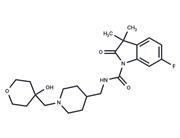| Name | Senicapoc |
| Description | Senicapoc (ICA-17043) is a potent inhibitor of the Gardos channel that ameliorates RBC dehydration in the SAD mouse. It blocks Ca2+-induced rubidium flux from human RBCs with an IC50 value of 11 ± 2 nM (CLT IC50 = 100 ± 12 nM) and inhibits RBC dehydration with an IC50 of 30 ± 20 nM. Senicapoc is used in the treatment of Sickle Cell Disease and Sickle Cell Anemia. |
| Cell Research | Senicapoc is dissolved in DMSO or 100% ethanol. The whole blood is initially diluted 1:1 with Modified Flux Buffer (MFB), consisting of 140 mM NaCl, 5 mM KCl, 10 mM Tris (tris(hydroxymethyl)aminomethane), 0.1 mM EGTA (ethyleneglycoltetraacetic acid) (pH=7.4). The blood is centrifuged at 1000 rpm, and the pellet comprised primarily of RBCs is washed 3 times with MFB. The cells are then loaded with?86Rb+?by incubating the washed cells with 86Rb+?at a final concentration of 0.185 MBq/mL (5 μCi/mL) in MFB for at least 3 hours at 37°C. After loading with 86Rb+, the RBCs are washed 3 times with chilled MFB. The cells are then incubated for 10 minutes with test compound (senicapoc) at concentrations that ranged from 1 nM to 10?000 nM. Efflux of?86Rb+?is initiated by raising intracellular calcium levels in the RBCs with the addition of CaCl2?and A23187 (a calcium ionophore) to final concentrations of 2 mM and 5 μM, respectively. After 10 minutes of incubation at room temperature, the RBCs are pelleted in a microcentrifuge, and the supernatant is removed and counted in a Wallac MicroBeta liquid scintillation counter. |
| In vitro | ICA-17043 is shown to block the Gardos channel of mouse (C57 Black) RBCs with an IC50 of 50±6 nM. ICA-17043 blocks this increase in cellular hemoglobin concentration in human RBCs in a concentration-dependent fashion[1]. |
| In vivo | ICA-17043?(10 mg/kg, p.o.) administration produces a significant decrease in Gardos channel activity measured at day 11 and 21 and is associated with a corresponding increase in red cell K+ content without changes in Na+ content. ICA-17043 (10 mg/kg, twice a day) induces a significant increase in Hct after 11 days of dosing in the SAD mouse[1]. Senicapoc (30 mg/kg, p.o.) reduces airway hyperresponsiveness, eosinophil numbers in bronchoalveolar lavage taken 48 hours post-allergen challenge, and vascular remodelling in the sheep[2]. |
| Storage | Powder: -20°C for 3 years | In solvent: -80°C for 1 year | Shipping with blue ice. |
| Solubility Information | DMSO : 50 mg/mL (154.64 mM), Sonication is recommended.
|
| Keywords | KcsA | Senicapoc | inhibit | ICA 17043 | Potassium Channel | ICA17043 | Inhibitor |
| Inhibitors Related | Minoxidil sulfate | Glibenclamide | (±)-Naringenin | Tolbutamide | Tetraethylammonium bromide | Halothane | Butamben | Cloperastine hydrochloride | 2,2,2-Trichloroethanol | Indapamide |
| Related Compound Libraries | Bioactive Compound Library | Pain-Related Compound Library | Membrane Protein-targeted Compound Library | Anti-Cancer Clinical Compound Library | Drug Repurposing Compound Library | Inhibitor Library | Bioactive Compounds Library Max | Potassium Channel Targeted Library | Ion Channel Targeted Library | Anti-Cancer Drug Library |

 United States
United States



